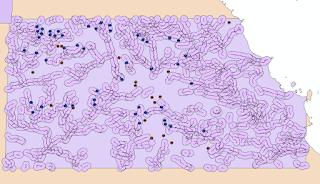INTRODUCTION
This lab demonstrates the ability to use various geoprocessing tools for vector analysis in arcGIS and a basic introduction to ArcGIS Python. Using a GPS MS Excel file of black bear locations in central Marquette County, Michigan, criteria was chosen to build a data flow model by using python script to find suitable bear habitat in the study area. This information was then used to recommend territory suitable for bears and away from urban environments to the DNR.
For the area of interest (AOI) of central Marquetty County, Michigan, the political boundaries of state, county, and DNR management were stored under a feature class and the study area, streams, and land cover were stored under another feature class while bear locations were stores as simple x,y coordinates all under a single geodatabase.
METHODOLOGY
First, the x,y coordinates of bear locations were converted into an event theme, which gives the layer a spatial quality with limitations. The layer was then exported as a feature class under the geodatabase to begin functions.
Land Cover & Proximity to Streams
In order to discover bear habitat, a spatial join combined bear locations with land cover. A summary of this new spatial join layer gave the most common land cover types bears were found. The top three land cover zones were chosen and made into a separate layer.
In order to further delineate bear territory, a buffer of 500 meters was created around streams. The bear locations was then spatially joined with this stream layer to discover the number of bears within 500 meters of a stream.
Creating a Bear Habitat Zone
Based on results from land cover and proximity to streams, a bear habitat was created using an intersect function of these two layers. To aggregate the output layer into a single land area, the dissolve function was used based on the stream buffer field.
DNR Bear Habitat Land
After aggregating all DNR land, a series of clips were performed to only show DNR land that contained bear habitat according to the previous results.
DNR Bear Habitat Away from Urban Environment
A separate layer was created from land cover based on urban and built up land. A 5 kilometer buffer was then created around this layer. Finally using the erase function, all DNR bear habitat land was erased within the 5 km buffer zone.
Python Script
After all analysis was completed, python script commands were performed to create a buffer around streams and intersect with bear habitat lands. Figure 1 shows the python script performed and the results gathered into a personal geodatabase.RESULTS
The AOI in central Marquetty County, Michigan after adding all feature classes from the dataset is shown in Figure 2.
Land Cover
After combining bear locations with areas of land cover, a summary statistics of the output layer was performed to give the most common land covers bears were located as shown by Figure 3. According to the results, mixed forest land, forested wetlands, and evergreen forest land were first, second, and third, respectively.
From these three land cover areas which hold the majority of bears, a new layer was created.
Proximity to Streams
Figure 4 shows the dark purple zones as a 500 meter buffer from every stream in the AOI. After a spatial join of the buffer area with bear locations was performed, an output of bear locations within 500 meters of a stream is visible by the blue points.
Out of the 68 bear locations, 49 of the bears were located within this buffer zone. According to biologists, if the percentage would exceed 30%, the data would be important. Therefore, at a 72% rate, this data would be considered highly significant.
Creating a Bear Habitat Zone
An intersection between the layer that held the top three land cover areas likely to contain bears and the buffer of 500 meters from a stream or river was produced as indicated by Figure 5. This intersection was based off the 500-meter buffer and therefore, the output drew from multiple polygons creating a dis-contiguous zone.
This zone was aggregated into a single, cohesive layer using the dissolve tool as indicated by the tan area in Figure 6.
DNR Bear Habitat Land
After dissolving all DNR land into a single unit, and a series of clips later, Figure 7 shows all DNR land in the AOI that are suitable for bears.
DNR Bear Habitat Away from Urban Environment
In Figure 8, the urban and built up lands are indicated by the gray territory, while the green lands represent DNR bear habitat land within a 5 km buffer zone of urban environment. Finally, the red areas represent all DNR bear habitat land located away from the urban environment.
Overview of Tasks Performed
Figure 9 shows the input and output layers used and the functions performed using ArcGIS including spatial joins, summaries, queries, buffers, clips, dissolves, and erases to achieve a final product.
Figure 10 is the completed project, accurately showing all bear habitat, urban areas, streams, DNR bear habitat lands 5km away from urban areas, GPS locations of bears, and a reference map showing the location of the area of study.
To find this data, the tasks performed and knowledge gained was both valuable and enjoyable. With a comprehensive knowledge of the tools in ArcGIS, there are various strategies available to derive a final product. The outlines of a project, such as DNR recommendations of suitable bear habitat, allow for creativity and full use of GIS functions.
SOURCES
All of the data were downloaded from the State of Michigan Open GIS Data http://gis.michigan.opendata.arcgis.com/
Landcover obtained from USGS NLCD
http://www.mcgi.state.mi.us/mgdl/nlcd/metadata/nlcdshp.html
DNR management units
http://www.dnr.state.mi.us/spatialdatalibrary/metadata/wildlife_mgmt_units.htm
Streams from
http://www.mcgi.state.mi.us/mgdl/framework/metadata/Marquette.html
Landcover obtained from USGS NLCD
http://www.mcgi.state.mi.us/mgdl/nlcd/metadata/nlcdshp.html
DNR management units
http://www.dnr.state.mi.us/spatialdatalibrary/metadata/wildlife_mgmt_units.htm
Streams from
http://www.mcgi.state.mi.us/mgdl/framework/metadata/Marquette.html










No comments:
Post a Comment